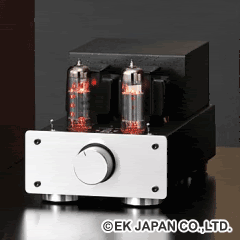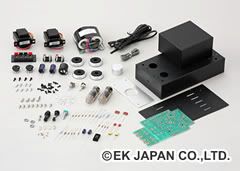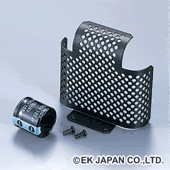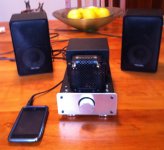Quoted from : www.audioasylum.com/forum/elekit/
Elekit Kits Forum - Bench tests and listening impressions - 4season - April 09, 2010 at 16:18:26
Posted by 4season (A) on April 09, 2010 at 14:56:42
It's a slow day at the office and I thought some of you might be entertained by my experiences with a trio of inexpensive Chinese amplifiers and the entry-level Elekit TU-870R.
General description and first impressions:
Chinese amp #1 is a 6P14P single-ended amp with USB DAC which costs about $400 shipped from the USA rep based in California. Fast delivery, really nicely packed, in double boxes, with custom-cut foam inserts. Really looks good with thick milled aluminum and stainless steel parts. Internally, it's pretty tidy with glass-epoxy circuit board, ceramic tube sockets, Rubycon electrolytics and Burr Brown PCM2792 DAC. A couple of the milled aluminum plates were a bit irregular, and some of the lettering on the front panel failed to adhere properly and had flaked off. A standard IEC power cord and basic but tidy owner's manual is provided, though there is no schematic, and the importer did not have one available.
Chinese amp #2 (approx $250 shipped) is billed as "World's smallest" tube amplifier, and it literally fits in the palm of my hand. It accomplishes this with surface mount construction and a switch mode power supply. The amp circuit is based on 6P1 tubes in single ended pentode configuration. I ordered mine through a Taiwan seller and received it about a week later. Also nicely packed, but without power cord or manual of any sort. I did eventually find the schematic published in a Chinese electronics magazine, though I don't read Chinese. Out of the box, it looked a little grimy and really benefited from a bit of detailing. Finish was a bit rough but workmanlike,
Chinese amp #3 ($220, shipped from USA-based distributer) was a departure for me as it's a solid state amp based on the Tripath TA2022 chip, good for around 50 watts into 8 ohms. Appearance is very simple but workmanlike, with rather rough milling around the corners of the thick front panel. Perhaps their tools were chipped or dull. Inside, it looked very good, with substantial toroidal transformer and tidy circuit board with large Cornell Dublier electrolytic capacitors in the power supply. On the underside is a large protruding bolt which anchors the power transformer. A power cord is included, but there is no documentation, though the circuit appears to be similar to the one published by Tripath.
The Elekit arrived from VK Music packed in a recycled carton containing a stock Japanese-market TU-870R kit, product brochures, English-language documentation, the optional power supply upgrade + tube protector I had ordered and most importantly, a 120V r-core power transformer to replace the 100V part included in the kit box. I like the vintage-look artwork on that box and wish someone would offer a poster or sign with that look. Obviously it's a kit whereas the others are fully assembled, but right away, it looked like a very different sort of product. No audiophile pretensions: Tube sockets are Bakelite, RCA jacks are nickel plated PC mounted types, power cord is a fixed, 2-conductor sort, and speaker connectors are the spring clip type. No gold platings to be seen. Even the chassis is mostly simple painted steel with an unadorned clear anodized front panel. I decided to build this 100% stock, closely following the instructions. Where I had several identical resistors or capacitors, I'd match left and right channels as closely as possible, otherwise, I used no special tricks.
Bench tests and listening impressions to follow.
Posted by 4season (A) on April 09, 2010 at 16:18:26
In Reply to: RE: My TU-870R vs 3 eBay Chinese amps posted by 4season on April 09, 2010 at 14:56:42
Chinese amp #1 initially sounded lean, constricted and bass-shy. After a number of hours of use, I either grew more accustomed to the sound, else it smoothed out a bit, but the basic sound didn't change much. The internal USB DAC worked without additional drivers from Windows Vista and Mac OS X computers, but buzzes noticeably with my HP notebook if I use the AC brick. Very likely there's a ground loop issue. Within a few weeks, one of the Beijing 6P14P output tubes failed. These aren't warranted, and the dealer sells replacements only in sets, along with the 5755 input tube. I chose to switch to Russian 6P14P-ER tubes, and all subsequent comments are based on the amp equipped with these tubes.
On the test bench, I looked at it's square wave performance and frequency response. Manufacturer's specs state an amazingly flat response from 30Hz-30kHz, and surprisingly, this is actually true--with sine waves. Square waves on the other hand, showed considerable overshoot and high-frequency oscillation. High-frequency square waves are oddly misshapen as a result. After manually tracing out the schematic and asking lots of questions, I discovered that the circuit board had been laid out incorrectly and hence, the circuit contained errors. Correcting the mistakes required cutting foil traces and jumpering others. That accomplished, the amp measured much, much better, and it sounded better too. There was free space inside the chassis, so I also ended up replacing the tiny stock output transformers with larger ones from Edcor.
Amp #2 had gotten rave reviews, and some folks were comparing it to amps costing thousands of dollars. To my ears, it was very forward and somewhat dry-sounding. Square waves showed massive overshoot and ringing. A tiny tweak to the feedback circuit greatly improved it, and I wondered why the factory hadn't invested the extra 10 cents to do it right in the first place. Sonically, the corrected amp was actually pretty decent from about 70Hz to 32kHz.
Amp #3 seemed promising, with a big, bass-rich sound right out of the box, but with noticeable hiss and hum. Possibly a bit bland compared to my slightly-modded $40 Dayton/Sonic Impact T-Amp but not bad. Radio frequency interference was a real problem though--as soon as I turned the amp on, I lost all HD Radio reception! On the test bench, I noted a fair amount of square wave overshoot + ringing, and the waveform overall looked "dirty", and my oscilloscope had difficulty locking onto it at all. The Dayton actually measures quite a bit better! Tripath's tech notes indicate a couple of small-value capacitors which are used to improve amplifier stability (ie reduce that square wave overshoot) but when I examined underside of this amp's circuit board, I discovered that they had provided space for such parts but had left them empty. I also discovered that major parts like the power supply capacitors were being run at full rated voltage! Ouch. This is an ongoing project, and all I'm retaining of the original amp is the case and power transformer (I suspect the original circuit board has layout errors that I can't correct), and even the transformer got modded to lower the voltage a couple of notches.
The dead-stock Elekit easily measured better than any of the 3 stock Chinese amps. Some square wave overshoot and ringing, but not bad, with bass rolling off a bit sooner, maybe due to the small size of the output transformers. The hardware was a bit of a surprise too: The sheet metal may be humble, but it's solid, and various parts are aligned perfectly: Screw holes are dead-centered, the bottom cover had no significant warps at all, and wonder of wonders, the edges of the front panel are ground smooth. I found that I even kind of like the stock speaker connector because it's extra-large and handles moderately fat wire without a fuss, whereas there's really not enough room to use binding posts here. I've also found that I really like the narrow form factor of the amp and it's 2nd line input.
Despite my various gripes about the Chinese amps, I do enjoy the sheer variety they offer, and I've come to expect that these are "projects" which may require reworking, sometimes extensive reworking. At the same time, I've enjoyed NOT having to fuss with the Elekit at all: It's a very unassuming thing, but there's some depth to it, and individual bits may be inexpensive, but there's a sense that some real thought went into selecting each one of them. To me, there's something very Japanese about humble everyday items of "regular" quality which are really well-done.



Optional Parts
Elekit Kits Forum - Bench tests and listening impressions - 4season - April 09, 2010 at 16:18:26
Posted by 4season (A) on April 09, 2010 at 14:56:42
It's a slow day at the office and I thought some of you might be entertained by my experiences with a trio of inexpensive Chinese amplifiers and the entry-level Elekit TU-870R.
General description and first impressions:
Chinese amp #1 is a 6P14P single-ended amp with USB DAC which costs about $400 shipped from the USA rep based in California. Fast delivery, really nicely packed, in double boxes, with custom-cut foam inserts. Really looks good with thick milled aluminum and stainless steel parts. Internally, it's pretty tidy with glass-epoxy circuit board, ceramic tube sockets, Rubycon electrolytics and Burr Brown PCM2792 DAC. A couple of the milled aluminum plates were a bit irregular, and some of the lettering on the front panel failed to adhere properly and had flaked off. A standard IEC power cord and basic but tidy owner's manual is provided, though there is no schematic, and the importer did not have one available.
Chinese amp #2 (approx $250 shipped) is billed as "World's smallest" tube amplifier, and it literally fits in the palm of my hand. It accomplishes this with surface mount construction and a switch mode power supply. The amp circuit is based on 6P1 tubes in single ended pentode configuration. I ordered mine through a Taiwan seller and received it about a week later. Also nicely packed, but without power cord or manual of any sort. I did eventually find the schematic published in a Chinese electronics magazine, though I don't read Chinese. Out of the box, it looked a little grimy and really benefited from a bit of detailing. Finish was a bit rough but workmanlike,
Chinese amp #3 ($220, shipped from USA-based distributer) was a departure for me as it's a solid state amp based on the Tripath TA2022 chip, good for around 50 watts into 8 ohms. Appearance is very simple but workmanlike, with rather rough milling around the corners of the thick front panel. Perhaps their tools were chipped or dull. Inside, it looked very good, with substantial toroidal transformer and tidy circuit board with large Cornell Dublier electrolytic capacitors in the power supply. On the underside is a large protruding bolt which anchors the power transformer. A power cord is included, but there is no documentation, though the circuit appears to be similar to the one published by Tripath.
The Elekit arrived from VK Music packed in a recycled carton containing a stock Japanese-market TU-870R kit, product brochures, English-language documentation, the optional power supply upgrade + tube protector I had ordered and most importantly, a 120V r-core power transformer to replace the 100V part included in the kit box. I like the vintage-look artwork on that box and wish someone would offer a poster or sign with that look. Obviously it's a kit whereas the others are fully assembled, but right away, it looked like a very different sort of product. No audiophile pretensions: Tube sockets are Bakelite, RCA jacks are nickel plated PC mounted types, power cord is a fixed, 2-conductor sort, and speaker connectors are the spring clip type. No gold platings to be seen. Even the chassis is mostly simple painted steel with an unadorned clear anodized front panel. I decided to build this 100% stock, closely following the instructions. Where I had several identical resistors or capacitors, I'd match left and right channels as closely as possible, otherwise, I used no special tricks.
Bench tests and listening impressions to follow.
Posted by 4season (A) on April 09, 2010 at 16:18:26
In Reply to: RE: My TU-870R vs 3 eBay Chinese amps posted by 4season on April 09, 2010 at 14:56:42
Chinese amp #1 initially sounded lean, constricted and bass-shy. After a number of hours of use, I either grew more accustomed to the sound, else it smoothed out a bit, but the basic sound didn't change much. The internal USB DAC worked without additional drivers from Windows Vista and Mac OS X computers, but buzzes noticeably with my HP notebook if I use the AC brick. Very likely there's a ground loop issue. Within a few weeks, one of the Beijing 6P14P output tubes failed. These aren't warranted, and the dealer sells replacements only in sets, along with the 5755 input tube. I chose to switch to Russian 6P14P-ER tubes, and all subsequent comments are based on the amp equipped with these tubes.
On the test bench, I looked at it's square wave performance and frequency response. Manufacturer's specs state an amazingly flat response from 30Hz-30kHz, and surprisingly, this is actually true--with sine waves. Square waves on the other hand, showed considerable overshoot and high-frequency oscillation. High-frequency square waves are oddly misshapen as a result. After manually tracing out the schematic and asking lots of questions, I discovered that the circuit board had been laid out incorrectly and hence, the circuit contained errors. Correcting the mistakes required cutting foil traces and jumpering others. That accomplished, the amp measured much, much better, and it sounded better too. There was free space inside the chassis, so I also ended up replacing the tiny stock output transformers with larger ones from Edcor.
Amp #2 had gotten rave reviews, and some folks were comparing it to amps costing thousands of dollars. To my ears, it was very forward and somewhat dry-sounding. Square waves showed massive overshoot and ringing. A tiny tweak to the feedback circuit greatly improved it, and I wondered why the factory hadn't invested the extra 10 cents to do it right in the first place. Sonically, the corrected amp was actually pretty decent from about 70Hz to 32kHz.
Amp #3 seemed promising, with a big, bass-rich sound right out of the box, but with noticeable hiss and hum. Possibly a bit bland compared to my slightly-modded $40 Dayton/Sonic Impact T-Amp but not bad. Radio frequency interference was a real problem though--as soon as I turned the amp on, I lost all HD Radio reception! On the test bench, I noted a fair amount of square wave overshoot + ringing, and the waveform overall looked "dirty", and my oscilloscope had difficulty locking onto it at all. The Dayton actually measures quite a bit better! Tripath's tech notes indicate a couple of small-value capacitors which are used to improve amplifier stability (ie reduce that square wave overshoot) but when I examined underside of this amp's circuit board, I discovered that they had provided space for such parts but had left them empty. I also discovered that major parts like the power supply capacitors were being run at full rated voltage! Ouch. This is an ongoing project, and all I'm retaining of the original amp is the case and power transformer (I suspect the original circuit board has layout errors that I can't correct), and even the transformer got modded to lower the voltage a couple of notches.
The dead-stock Elekit easily measured better than any of the 3 stock Chinese amps. Some square wave overshoot and ringing, but not bad, with bass rolling off a bit sooner, maybe due to the small size of the output transformers. The hardware was a bit of a surprise too: The sheet metal may be humble, but it's solid, and various parts are aligned perfectly: Screw holes are dead-centered, the bottom cover had no significant warps at all, and wonder of wonders, the edges of the front panel are ground smooth. I found that I even kind of like the stock speaker connector because it's extra-large and handles moderately fat wire without a fuss, whereas there's really not enough room to use binding posts here. I've also found that I really like the narrow form factor of the amp and it's 2nd line input.
Despite my various gripes about the Chinese amps, I do enjoy the sheer variety they offer, and I've come to expect that these are "projects" which may require reworking, sometimes extensive reworking. At the same time, I've enjoyed NOT having to fuss with the Elekit at all: It's a very unassuming thing, but there's some depth to it, and individual bits may be inexpensive, but there's a sense that some real thought went into selecting each one of them. To me, there's something very Japanese about humble everyday items of "regular" quality which are really well-done.



Optional Parts
Last edited:
Elekit amp kits
Hello VKUNG,
i have not read your thread yet , but will. I am new to DIY HP AMP BUILDING
and do you have a recomend for a elekit tube amp build ? i understand Elekit
is a japan makes the amp kit ? my son is going to Japan soon and i was goin to have him bring a kit or 2 back if they are worth it.
thanks for any thoughts you may have.
HJL857
Hello VKUNG,
i have not read your thread yet , but will. I am new to DIY HP AMP BUILDING
and do you have a recomend for a elekit tube amp build ? i understand Elekit
is a japan makes the amp kit ? my son is going to Japan soon and i was goin to have him bring a kit or 2 back if they are worth it.
thanks for any thoughts you may have.
HJL857
Elekit tu-8300 for the beginner ?
VKUNG
Being i have only built one cmoy the TU-8300 ,is this a tube amp?
where can i get info for the kit, this is a complete diy kit ? for me a step by step build manual is a must.PICTURES WOULD BE A GREAT HELP, on a difficulty scale for building this amp 10 being very hard and 1 being easy your grandma could build with no experience, where dose this amp fit in? building a flag ship amp may be out of my league. can you compare build to any of the american amp kits ? SOUND QUALITY & PRICE.
THANKS !
VKUNG
Being i have only built one cmoy the TU-8300 ,is this a tube amp?
where can i get info for the kit, this is a complete diy kit ? for me a step by step build manual is a must.PICTURES WOULD BE A GREAT HELP, on a difficulty scale for building this amp 10 being very hard and 1 being easy your grandma could build with no experience, where dose this amp fit in? building a flag ship amp may be out of my league. can you compare build to any of the american amp kits ? SOUND QUALITY & PRICE.
THANKS !
If you send your email address, I can send you the first 2 pages of the manual. Evethough, TU-8300 is the flagship of Elekit but this kit is very easy to build.
TU-8300 is a complete kit
or visit my site VKMusic.ca Home page for more info.
TU-8300 is a complete kit
or visit my site VKMusic.ca Home page for more info.
Last edited:
- Status
- This old topic is closed. If you want to reopen this topic, contact a moderator using the "Report Post" button.
